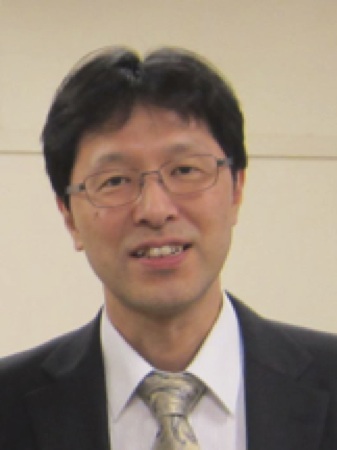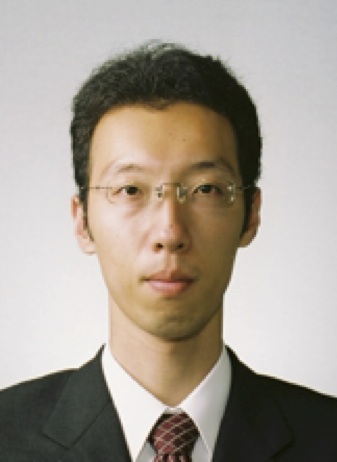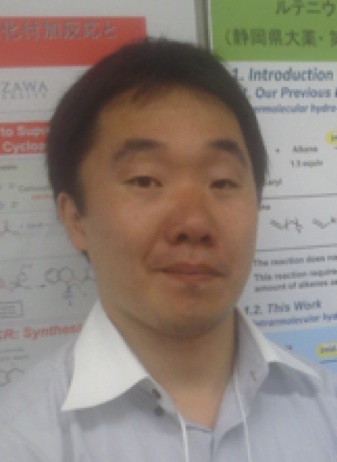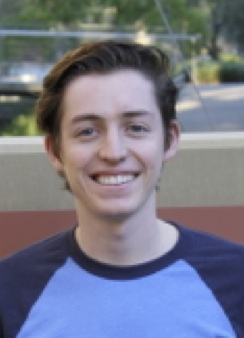Org. Synth. 2017, 94, 66-76
DOI: 10.15227/orgsyn.094.0066
Palladium-catalyzed External-CO-Free Reductive Carbonylation of Bromoarenes
Submitted by Hideyuki Konishi,
1 Masataka Fukuda,
1 Tsuyoshi Ueda,
2 and Kei Manabe
1*
Checked by Jordan C. Beck and Sarah E. Reisman
1. Procedure
4-Phenylbenzaldehyde (1). A 1-L, three necked, round-bottomed flask equipped with a Teflon-coated, oval magnetic stir bar (45 mm × 22 mm), a rubber septum (left neck), a 500-mL graduated, pressure-equalizing addition funnel fitted with a rubber septum at the top (center neck), and an inlet adapter fitted with an argon inlet (right neck) (
Note 1) is charged with
palladium acetate (337 mg, 1.50 mmol, 3 mol%) (
Note 2),
1,4-bis(diphenylphosphino)butane (
DPPB) (960 mg, 2.25 mmol, 4.5 mol%),
4-bromobiphenyl (11.7 g, 50.0 mmol, 1.00 equiv), and
sodium carbonate (7.95 g, 75.0 mmol, 1.50 equiv) (
Note 3) by temporarily removing the septum from the left neck. The flask is evacuated and backfilled with
argon three times.
Dimethylformamide (
DMF) (50 mL) (
Note 4) is added through the addition funnel. The mixture is stirred at room temperature for 20 min, during which the addition funnel is charged with a solution of
N-formylsaccharin (21.1 g, 100 mmol, 2.00 equiv) (
Note 5) and
triethylsilane (10.3 mL, 65.0 mmol, 1.30 equiv) (
Note 6) in
DMF (400 mL) (
Note 7) via cannula transfer. The rubber septum on the left neck is fitted with a thermocouple temperature probe, and then the mixture is warmed to 80 °C (internal temperature) in an oil bath. The
argon inlet is replaced by an empty rubber balloon (Figure 1) (
Note 8). The solution inside the addition funnel is slowly added to the flask over 2 h with stirring (
Note 9). During the addition, the temperature of the oil bath is adjusted to maintain an internal temperature of 80 ± 3 °C.
Figure 1. Reaction Apparatus with Balloon
After complete addition, the resulting orange solution is stirred at 80 °C (internal temperature) for another 16 h, at which point TLC indicated significant consumption of starting material. (
Note 10). The reaction mixture is then passed through a short pad of silica gel (35 g), which is washed with
EtOAc (200 mL). (
Note 11). Then, the solvent is removed using a rotary evaporator under reduced pressure (80 °C, 20 mmHg). The resulting black slurry is diluted with
ethyl acetate (80 mL) and
water (100 mL). The layers are partitioned in a 500-mL separatory funnel. The aqueous layer is extracted with additional
ethyl acetate (2 x 100 mL). The combined organic layers are washed with brine (150 mL), dried over anhydrous
sodium sulfate (81 g), filtered through a funnel fitted with a cotton plug, and concentrated on a rotary evaporator under reduced pressure (40 °C, 80 mmHg) to afford a brown oil. The obtained residue is purified by column chromatography (
Note 12) to afford 7.06 g (38.7 mmol, 77%) (
Note 13) of
4-phenylbenzaldehyde (
1) as a white solid (Notes
14 and
15).
2. Notes
1. All glassware was flame-dried under vacuum (3 mmHg) and backfilled with
argon while hot. During the course of the reaction, the static internal atmosphere consisted of
argon and the
carbon monoxide (
CO) that was chemically generated inside the flask.
2.
Palladium acetate (≥99.9% trace metal basis) was purchased from Sigma-Aldrich and was used after purification as described previously.
33.
Bis(diphenylphosphino)butane (
DPPB) (>98%) was purchased from Wako Pure Chemical Industries, Ltd.
4-Bromobiphenyl (>95%) was purchased from Tokyo Chemical Industry Co., Ltd. (TCI).
Sodium carbonate (>99.5%) was purchased from Kanto Chemical Co., Inc. These reagents were used as received.
4.
Dimethylformamide (
DMF) (dehydrated "Super," >99.5%) was purchased from Kanto, and was purified by using a Glass Contour Solvent Purification System prior to use. Use of reagent-grade
DMF without further purification delivered the desired product in diminished yield (66%).
5.
N-Formylsaccharin was synthesized according to the literature method.
4 This compound is also commercially available from Wako and TCI; however, the checker's found that the commercial material is poorly soluble in
DMF and results in lower yields. The use of freshly prepared
N-formyl saccharin is recommended.
6.
Triethylsilane (>98%) was purchased from TCI and used as received.
7. A flame-dried 1L round-bottomed flask was charged with
N-formylsaccharin, evacuated and backfilled three times with
argon, then charged with 400 mL of
DMF via cannula. This mixture was manually agitated for 5 min to ensure full dissolution of the
N-formylsaccharin, then was charged with
triethylsilane, and the resulting solution was transferred to a 500 mL graduated addition funnel via cannula.
8. An empty balloon was employed to maintain an internal pressure equal to 1 atm in case the generation of
CO caused a sudden increase in the internal pressure (see photo).
Caution! The reaction should be conducted in a well-ventilated fume hood in case of a leak of carbon monoxide.9. The balloon attached to the flask inflated during the period of slow addition. The yield is decreased if addition of the solution is too rapid.
10. The reaction was monitored by TLC, hexane/ethyl acetate (19:1). SM: R
f=0.69, Ligand: R
f=0.42, Product: R
f=0.36.
11. Extra caution should be taken by safely opening the flask inside a fume hood, because
CO might remain inside the flask.
12. Column chromatography was performed using an 8-cm wide, 20-cm high column containing 370 g Kanto Silica Gel 60 N (spherical, neutral, 63-210 µm) packed as a slurry in hexane. The residue was dissolved with a minimum amount of dichloromethane (15 mL), and loaded onto the column. The flask containing the crude material was then washed with 10 mL of 1:1 hexanes/dichloromethane and loaded onto the column. The column was eluted with hexane/ethyl acetate (40:1), and a 2.5-L forerun was collected (containing trace SM and ligand). The column was then eluted with 800 mL hexane/ethyl acetate (40:1), and 100-mL fractions were collected using 125 mL Erlenmeyer flasks. The column was then eluted with 700 mL hexane/ethyl acetate (35:1), followed by 1.2 L hexane/ethyl acetate (30:1), followed by 800 mL hexane/ethyl acetate (20:1). The product was contained in fractions 9-34. Elution of product was monitored by TLC, hexane/ethyl acetate (19:1). SM: R
f=0.69, Ligand: R
f=0.42, Product: R
f=0.36. The combined fractions containing the desired product were concentrated on a rotary evaporator under reduced pressure (40 °C, 100-120 mmHg).
13. A second reaction on the same scale provided 6.80 g (75%) of the same product with similar purity.
14.
4-Phenylbenzaldehyde showed the following characterization data: mp 57.3-57.9 °C; R
f = 0.36 (hexane/ethyl acetate 19:1);
1H NMR
pdf(500 MHz, CDCl
3) δ: 7.42 (ddt,
J = 8.1, 6.6, 1.3 Hz, 1H), 7.46-7.51 (m, 2H), 7.63-7.66 (m, 2H), 7.76 (dt,
J = 8.3, 1.8 Hz, 2H), 7.96 (ddd,
J = 8.3, 2.4, 1.8 Hz, 2H), 10.06 (s, 1H);
13C NMR
pdf(101 MHz, CDCl
3) δ: 127.5, 127.8, 128.6, 129.2, 130.4, 135.3, 139.9, 147.4, 192.1; IR (NaCl) 3031, 2360, 1700, 1604, 1560, 1450, 1412, 1386, 1308, 1214, 1169, 1007, 836, 760, 695 cm.
−115. Purity of the product was assessed at >99% by quantitative
1H NMR
pdf using dimethyl fumarate as the internal standard.
Working with Hazardous Chemicals
The procedures in
Organic Syntheses are intended for use only by persons with proper training in experimental organic chemistry. All hazardous materials should be handled using the standard procedures for work with chemicals described in references such as "Prudent Practices in the Laboratory" (The National Academies Press, Washington, D.C., 2011; the full text can be accessed free of charge at
http://www.nap.edu/catalog.php?record_id=12654). All chemical waste should be disposed of in accordance with local regulations. For general guidelines for the management of chemical waste, see Chapter 8 of Prudent Practices.
In some articles in Organic Syntheses, chemical-specific hazards are highlighted in red "Caution Notes" within a procedure. It is important to recognize that the absence of a caution note does not imply that no significant hazards are associated with the chemicals involved in that procedure. Prior to performing a reaction, a thorough risk assessment should be carried out that includes a review of the potential hazards associated with each chemical and experimental operation on the scale that is planned for the procedure. Guidelines for carrying out a risk assessment and for analyzing the hazards associated with chemicals can be found in Chapter 4 of Prudent Practices.
The procedures described in Organic Syntheses are provided as published and are conducted at one's own risk. Organic Syntheses, Inc., its Editors, and its Board of Directors do not warrant or guarantee the safety of individuals using these procedures and hereby disclaim any liability for any injuries or damages claimed to have resulted from or related in any way to the procedures herein.
3. Discussion
Among a number of synthetic methods to obtain aromatic aldehydes, formylation is a powerful strategy because an aldehyde moiety is directly introduced into a target molecule, accompanied by the formation of a new C-C bond.
5 The Vilsmeier-Haack
6 and Reimer-Tiemann
7 formylations are classical, reliable methods that introduce a formyl group into a benzene ring, although they can be applied only to acid- or base-tolerant substrates. In contrast, the transition metal-catalyzed formylation of haloarenes using
carbon monoxide (
CO) and a reductant
8 has gained wide applicability due to the mildness of the reaction conditions. The reaction is called reductive carbonylation because it consists of a carbonylation and the addition of hydride.
Normally, synthesis gas is used as the
CO source and reductant in transition metal-catalyzed reductive carbonylations.
9 However, the use of
CO is hampered, especially in small laboratories, by its unfavorable features as a highly toxic, flammable gas. It is also troublesome that chemists must use special techniques for handling high pressure experiments and adhere to various regulations for treating pressurized gas.
Recently, the use of
CO surrogates instead of
CO gas has become recognized as a safer and more efficient concept for the development of organic reactions utilizing
CO.
10 A
CO surrogate is a special compound that can generate
CO "on-demand" by chemical reaction or physical stimulus. This external-
CO-free concept is quite effective, especially for small-scale experiments, because exposure to toxic
CO is minimized due to its generation and consumption in a closed reaction flask during an organic reaction. While various
CO surrogates have been reported, most require high temperature (>100 °C), transition metals, or a special 2-chamber reaction apparatus.
We discovered that phenyl formate could generate
CO at 80 °C in the presence of a weak base such as triethylamine.
11 Shortly thereafter, we developed 2,4,6-trichlorophenyl formate as a highly reactive
CO surrogate.
12 This compound can immediately generate
CO at room temperature, and is applicable to the Pd-catalyzed aryloxycarbonylation of haloarenes, even on multi-gram scale.
13 However, these formates could not be used for reductive carbonylation because the nucleophilicity of the phenoxides that were formed by the generation of
CO was stronger than that of hydride, resulting in the substantial formation of aryl esters. This situation was totally changed by our finding that
N-formylsaccharin could generate
CO and a less nucleophilic by-product. A combination of
N-formylsaccharin and
triethylsilane worked effectively to afford aromatic aldehydes under Pd catalysis.
14N-Formylsaccharin is a highly crystalline
CO surrogate and stable under inert conditions or in a refrigerator. It can easily be synthesized by a standard formylation protocol using formic acid and acetic anhydride. It is also commercially available from several chemical suppliers.
15 It was previously developed as a germicide
16 and a formylating agent.
4 The generation of
CO is complete within several minutes at room temperature when it reacts with weak bases such as triethylamine, showing high reactivity. Some inorganic bases are also effective for the generation of
CO from
N-formylsaccharin. However, it has several drawbacks. It gradually decomposes to saccharin and formic acid with exposure to moisture or dissolution in DMSO. Decomposition can be effectively avoided by using
DMF as the solvent, although a relatively large quantity of the solvent is needed due to the low solubility of
N-formylsaccharin.
Notably, the title reaction features high safety and practicality, which are not realized in conventional formylation methods. The reaction proceeds smoothly with only 2 equivalents of the weighable CO surrogate at acceptably low temperature. Because neither excess CO gas from a CO cylinder nor a pressure-tolerant reaction vessel is required, special techniques and precautions for high-pressure experiments are not needed. This also helps reduce the risk of exposure to toxic CO. After quenching the reaction, the saccharin by-product can be removed easily by simple washing with saturated aq. NaHCO3 solution.
In terms of scope, a series of aldehydes was synthesized according to the present reaction protocol on 5 mmol scale (Table 1). Noteworthy is the wide applicability of the reaction conditions, especially to substrates bearing carbonyl groups, which are not compatible with other formylation conditions that use strongly nucleophilic organometallic reagents.
During the reaction, the yield can be quite effectively improved by maintaining low concentrations of both the
N-formylsaccharin and
triethylsilane through their slow addition. This gradual addition of
N-formylsaccharin realizes slow and continuous
CO generation at a constant rate, which prevents the excessive ligation of
CO to the Pd center. The slow addition of hydride might help to suppress the undesired dehalogenation of the substrate.
17
Table 1. Reductive Carbonylation of Other Bromoarenes
Appendix
Chemical Abstracts Nomenclature (Registry Number)
Palladium acetate: Acetic acid, palladium(2+) salt (2:1); (3375-31-3)
1,4-Bis(diphenylphosphino)butane (DPPB): Phosphine, 1,1'-(1,4-butanediyl)bis[1,1-diphenyl-; (7688-25-7)
4-Bromobiphenyl: 1,1'-Biphenyl, 4-bromo-; (92-66-0)
Sodium carbonate: Carbonic acid sodium salt (1:2); (497-19-8)
N-Formylsaccharin: 1,2-Benzisothiazole-2(3H)-carboxaldehyde, 3-oxo-, 1,1-dioxide; (50978-45-5)
Triethylsilane: Silane, triethyl-; (617-86-7)
4-Phenylbenzaldehyde; (1) (3218-36-8)

|
Kei Manabe was born in Kanagawa, Japan. He completed his doctoral work in 1993 at the University of Tokyo. After working as a postdoctoral fellow at Columbia University, USA, he returned to the University of Tokyo and worked as an Assistant Professor, Lecturer, and Associate Professor. In 2005, he moved to RIKEN as an Initiative Research Scientist. He joined the faculty at University of Shizuoka as a Professor in 2009. His research interests include the development of new catalytic reactions for organic synthesis. |

|
Hideyuki Konishi was born in Takamatsu, Japan in 1979. He obtained his Ph.D. degree in pharmaceutical sciences at the University of Tokyo in 2008 under the direction of Professor Shu Kobayashi. He carried out his postdoctoral research in Professor Viresh H. Rawal's laboratory at the University of Chicago. In 2009, he became a Research Assistant Professor in the group of Professor Kei Manabe at University of Shizuoka. His research interests include the development of practical and efficient catalytic reactions for the synthesis of pharmaceutically and synthetically important compounds. |

|
Masataka Fukuda was born in Shizuoka prefecture, Japan, in 1993. In 2016, he began pursuing the M.S. degree under the guidance of Professor Kei Manabe at University of Shizuoka. His research interest is focused on safe and practical Pd-catalyzed carbonylations using CO surrogates. |

|
Tsuyoshi Ueda was born in Ishikawa prefecture, Japan, in 1978. He received his M.S. degree in 2003 in Industrial Chemistry from Meiji University and subsequently joined the Department of Process Development at Sankyo Co., Ltd. He completed his Ph.D. under the guidance of Professor Kei Manabe at University of Shizuoka in 2013. He is currently a Senior Researcher at Daiichi Sankyo Co., Ltd., working on the development of practical and scalable synthetic methods for the synthesis of active pharmaceutical ingredients. |

|
Jordan C. Beck was born and raised in Los Angeles, CA. He received his B.S. from Brown University where he conducted research in the lab of Professor Amit Basu focused on the stereo and regioselective oligomerization reactions of galactose moieties. He is currently pursuing his Ph.D. in the lab of Professor Sarah E. Reisman. His graduate research focuses on the total synthesis of novel natural products. |
Copyright © 1921-, Organic Syntheses, Inc. All Rights Reserved